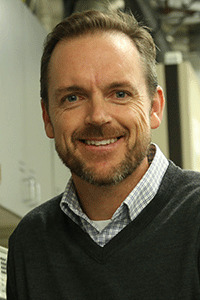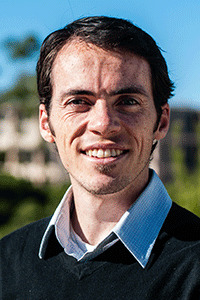 Two professors in the University of Utah’s College of Engineering have each received the National Science Foundation’s prestigious CAREER Award for their work in developing the use of low-frequency magnetic fields to power medical implants and for creating tools to discover new materials for capturing energy. Each award is for five years.
Two professors in the University of Utah’s College of Engineering have each received the National Science Foundation’s prestigious CAREER Award for their work in developing the use of low-frequency magnetic fields to power medical implants and for creating tools to discover new materials for capturing energy. Each award is for five years.
Mechanical engineering assistant professor Shad Roundy received his award to research a way to use low-frequency magnetic fields to provide electrical power to medical implants such as a continuous blood glucose monitor or a metabolic sensor.
Medical devices that are surgically implanted have one key problem: They require battery power that ultimately runs out. Consequently, when they are depleted, they must be surgically removed and replaced. But Roundy and his team believe they can develop a system in which a small implantable device with a magnetoelectric power receiver can draw power from an external transmitter that the user could wear outside the body.
The target of the team is to safely supply 100 microwatts per cubic millimeter of power to a wide range of implanted sensors and therapeutic devices. These low-frequency magnetic fields are a viable option because of their low-absorption in human tissue.
“We’re just thrilled and honored that the NSF liked our ideas and approach,” Roundy said. “This is really going to enable us to look at it a little longer term and be a little more creative in looking at ways of powering them.”
Roundy graduated from Brigham Young University with a bachelor’s in 1996 in mechanical engineering. He then received his master’s and a doctorate in mechanical engineering from the University of California, Berkeley.
Materials science and engineering assistant professor Taylor Sparks has received an NSF CAREER Award for his project of developing tools to more safely and effectively discover new materials that could be used to harvest wasted energy.
 Typically, about 60 percent of energy used from things such as a laptop computer, cell phone or even power lines is wasted in the form of heat. “If you can recover even small amounts of that, there is tremendous potential for energy,” Sparks said.
Typically, about 60 percent of energy used from things such as a laptop computer, cell phone or even power lines is wasted in the form of heat. “If you can recover even small amounts of that, there is tremendous potential for energy,” Sparks said.
So he and his team have partnered with a software development company to develop tools that can take huge amounts of data about all known materials and suggest the best sustainable thermoelectric compounds that can extract this wasted energy. The software company will develop the programs, while Taylor and his team will provide the database of materials and validate the software’s results.
“In essence it works like Netflix. If you watch season after season of ‘Battlestar Galactica’ or give it five stars, then it can suggest with high probability that you might also like ‘Star Trek: The Next Generation,’” he said about how the software would work. “Instead of picking random compositions out of a hat to discover new materials, we rely on computationally inexpensive statistical probabilities of thermoelectric performance to predict what new materials might be great performers, and then we go make them.”
By successfully coming up with compound materials that can absorb the heat and convert it to energy, these materials could be key to increasing the energy efficiency for any powered device.
Sparks earned his bachelor’s in materials science and engineering from the U in 2007, a master’s in materials from the University of California, Santa Barbara, and a doctorate in applied physics from Harvard University.